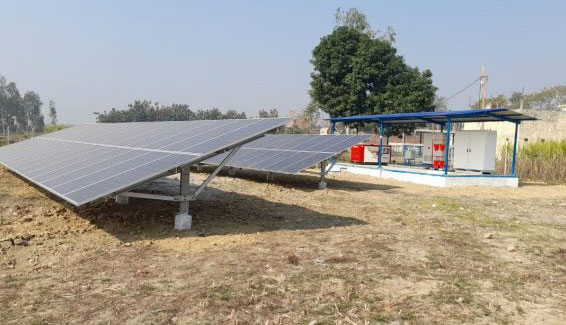
Headquartered in Kolkata, West Bengal, Hamara Grid Private Limited was founded in July 2020 with a vision to provide services in the rural minigrid space. In order to maximise local impact, the main objective of the company is to scale sustainable minigrid solutions in emerging markets, in partnership with key stakeholders.
“The entire core team, which had been working together for the previous eight to nine years in Mlinda Foundation, moved out and established Hamara Grid,” says Colonel Vijay Bhaskar, managing director, Hamara Grid.
Portfolio
Bhaskar shares that since its inception, the company has worked extensively in Jharkhand’s Gumla district to design, install, commission and operate 40 solar-powered minigrids with an installed base of 1,000 kWp. These minigrids have increased the personal income of electricity consumers by 20 per cent year on year. The company follows the prepaid model for these minigrids, and all the payments are made through mobile payment platforms such as Paytm.
In the past three months, Hamara Grid has incubated approximately 68 micro enterprises in three villages across Nagaland, where they have set up minigrids. The company has started powering public infrastructure for the first time in the village councils, setting up street lights and powering them with renewable energy.
Key collaborations
In India, the company is collaborating with Smart Power India to develop the capacity of the staff operating the microgrids of TP Renewable Microgrid, a wholly owned subsidiary of Tata Power, in order to boost energy demand and incubate local micro-enterprises in Bihar and Uttar Pradesh.
Furthermore, the company has also partnered with the Transform Rural India Foundation to identify and install scalable productive loads in their operational minigrids across the Kurdeg block of Simdega in Jharkhand. This was done at the request of the World Resources Institute India. The purpose of the collaboration is to promote an increase in the inclusive, sustainable, environmentally friendly and productive use of the energy supplied by the minigrids.
The company also has a presence in Myanmar. In order to increase the performance of minigrids in Myanmar, Hamara Grid has partnered with Smart Power Myanmar and other minigrid developers. This was done to provide monthly technical advisory engagements with developers, improving the commercial viability of solar minigrids by enabling the productive use of energy and technical optimisation of the solar minigrids. Ayeyarwady, Bago, Sagaing and Tanintharyi are the four regions of Myanmar where the company has partnered with developers to create demand for scalable productive loads. Additionally, in Myanmar, Hamara Grid has assisted in strengthening the capacities of local teams for minigrid demand management.
Key operational challenges
“One of the most important operational challenges faced by Hamara Grid is that Nagaland, being at the remote end of the country, receives electricity via a long transmission line coming from Assam. Therefore, the power tends to be weak and unreliable. Due to storms and heavy rainfall, trees fall and lines are cut for almost a week at times,” says Bhaskar.
Furthermore, the company sources its equipment from all over India. The batteries come from Hyderabad, Vijayawada, Visakhapatnam, Udaipur or Sanand, while the solar panels come from Kolkata. Hamara Grid faces disruptions with logistics, as the equipment often travels more than 2,000 km to reach Nagaland, which has a hilly terrain. “As the villages are on top of the mountains, the cost premium is almost 20 per cent,” says Bhaskar.
The way forward
“Going forward, in over 1,000 villages across Northeast India, Hamara Grid will collaborate with rural communities to provide 24/7 clean electricity. This development mission will begin in the Mon district of Nagaland, which is home to Konyak tribe,” says Bhaskar.
The project in Nagaland is being carried out in collaboration with the District Administration of Mon district, the village councils, Smart Power India, National Bank for Agriculture and Rural Development and World Resources Institute. Over the next three and a half years, the company intends to gradually electrify all 132 villages in Mon district, affecting 237,600 Konyak people. The project will be implemented in three phases: 15 villages in the first phase, 35 in the second and the remaining in the third phase. A special purpose vehicle for the Mon project, a non-profit company called Mithun Rural Development Foundation, has been floated. The first three pilot solar minigrids, which supply power to 650-700 Konyak tribal households, became operational at the end of January 2021.
“The government has fulfilled the requirement of building infrastructure to electrify all Indian villages, but going forward, the aim should be to provide reliable electricity to every household. This will help in improving market linkages and also build entrepreneurship in the villages,” he says.
By Anusshka Duggal


